
Several months ago, in Column Chart to Replace Multiple Pie Charts I showed how a column or bar chart could display a table of data more effectively than four pie charts could. Another alternative is to build a panel chart, a shown above.
Let’s review the sequence. The data shows how four business measures (Hours, Cost, Profit, and Sales) are apportioned among four categories of employees (Engineer 1 and 2, and Marketing 1 and 2).

Here are the pie charts. Very pretty, colorful and symmetrical and all. But it’s not really easy to compare the actual wedge sizes within and between the pies.

A clustered column chart plots all data on the same baseline, and the value is proportional to the one-dimensional size of the bars, not to a two-dimensional arc length.
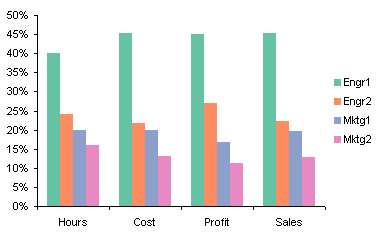
The column chart could be improved by removing the legend and labeling chart series directly. In order to prevent labels from overlapping other labels and other series, it may be necessary to rotate the labels into harder to read orientations. However, we can rotate the whole chart, and retain legible labels in a clustered bar chart.

Finally, for some situations, a panel chart may be an improvement over any of the preceding alternatives. This article shows how to construct a 2-by-2 panel chart. The procedures are easily scalable to any practical R-by-C arrangement.

Panel Chart Data
The original data is shown in the heavy border in B2:F6. This data needs to be rearranged and augmented before we can create the chart.
The data is color coded as follows:
- Green – used for series names in the chart
- Purple – used for series category labels or X data
- Blue – used for series Y data
- Yellow – used for custom data labels on data points
- Orange – user inputs for on-the-fly customizations
Note: I use Rob Bovey’s Chart Labeler to apply custom labels from a worksheet range to a chart series. This is a free Excel add-in which interfaces so well with Excel’s interface that it seems built in. Rob’s utility actually links each data label to a cell, so if the cell’s contents change, the label also changes. The utility also applies the font formatting of the cell to the label, so these ranges in the data below have different formatting from the rest of the worksheet.
The data in B11:M16 will produce the bars that display the actual data, and C8:M9 contains the labels that will show the employee category in the base of each bar. To ensure that Excel correctly parses the data when you create the chart, select cell C11, type a space character, and press Return. This makes Excel think there’s a label in C11, so it starts tie category label range in C11 instead of D11.
The value in cell H3 is the maximum sized bar that will fit vertically in each panel. The largest value in the table is 45.3%, which is bumped up to 50%, then an additional margin is added for the titles in the upper end of each panel, making this height factor 0.6 or 60%.
Range B18:D23 contains the data needed for the XY series that will locate the titles in each panel. The factor of 0.85 in cell D18 means that the titles will be located at 0.85 (85%) of the way from the bottom to top of each panel. The purple values were derived as follows. The column chart has columns in slots 1, 2, 3, 4, etc. Slots 1, 6, and 11 (columns C, H, and M) have zero-height columns, and are located at panel boundaries. We want the titles centered within each panel. An XY point plotted on the category axis is positioned according to the slot numbers. The X positions for the XY points are then (1+6)/2 = 3.5 and (6+11)/2 = 8.5.
Range F18:H24 contains data to define the vertical axis and its labels. The labels in H19:H21 are selected by the user, and axis ticks and labels will be placed at the appropriate positions. The X values of 1 in F19:F24 were derived as follows. The column chart has columns in slots 1, 2, 3, 4, etc. A zero-height bar (column C) is plotted in slot 1, along the left edge of the chart. Therefore we want the axis at X=1.

These ranges are not populated by hand, of course. I’m too lazy to keep changing everything when I make a minor adjustment to the chart. The following table shows which formulas to use. Select the indicated range with the first cell of the range as the active cell, type in the corresponding formula, then hold CTRL while pressing Enter.

Building the Panel Chart
The first step of the process is to select B11:M16 and create a stacked column chart (below left). Notice how the data arrangement in B11:M16 and the formulas for the “blank” series lead to the appearance in the chart.
Make the “blank” series invisible: format it so it has no border and no fill. Now the Sales and Profit bars float above the Cost and Hours bars (below right).
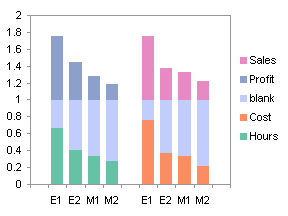

Notice the margins on the left and right of the plot area (left of the first E1 and right of the second M2 categories) are the same width as the gap between the first M2 and second E1 categories. We want the left and right margins to be half as wide as they are. This is easy, simply format the category axis so that the box for “Value (Y) axis crosses between categories” is unchecked (below left).
We’re not going to use the axis labels that Excel wants us to use, so let’s clean up the axes. Format each so that no axis features are visible: no line, no major or minor tick marks, and no tick labels. Delete the legend as well (below right).

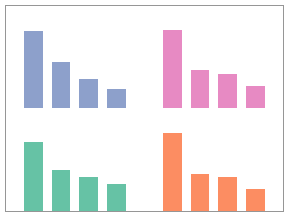
The plot area now expands to fill the chart area. Select the plot area, and drag its left edge to the right to make room for the axis labels we will be adding. Drag the top and bottom edges toward each other slightly. Add panel boundaries. First format the value (Y) axis so it has fixed (not auto) values of 0 and 2 for min and max, and 1 for major unit. Format the category (X) axis so there are 5 categories between tick marks. Then add major horizontal and vertical gridlines, matching the line color to the border color of the plot area.
The next few steps will add the panel titles. First copy the range C19:D23, then select the chart, and use Paste Special to add the data as a new series, with series data in columns, categories in the first column (don’t replace existing categories), and series names in the first row. This produces the red-bordered stack of columns that fit poorly into the chart below at right.
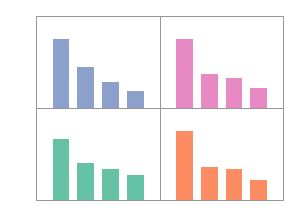
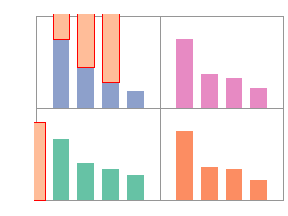
Right click this new series, and choose Chart Type (or Select Chart Type) from the pop-up menu. Select an XY type. The series has converted itself to the backwards “Z” in the left hand chart below.
Excel ever so helpfully placed this XY series onto secondary axes, but we will keep it simple stupid by formatting the series so it plots on the primary axes with the stacked columns.
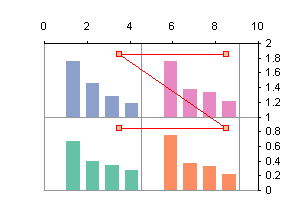
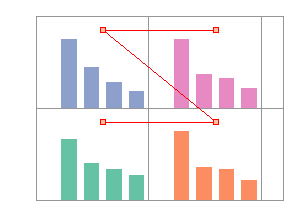
Cycling the chart’s secondary axes on and off have messed up the primary category axis. Select it (click on it carefully, it’s still there), and again uncheck the “Value (Y) axis crosses between categories”box (below left).
Time to fire up Rob’s chart labeler. Select the chart, then choose “XY Chart Labels” from the Tools menu (or from the Add-Ins tab in Excel 2007), and select the Add Chart Labels command. In the Labeler dialog, select the Titles series, the range B20:B23, and the Center position. The labels now appear centered over the XY markers (below right).
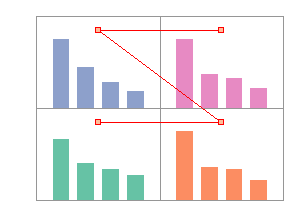
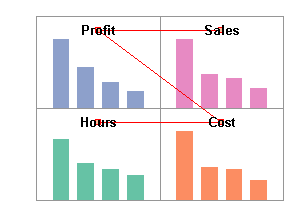
Hide the Titles series by formatting it to show no markers and no lines. You can adjust the vertical position of the titles by changing the value in cell D18.
The next several steps add the Y axis labels. Copy F18:G24, select the chart, and add the data as a new series using the same options as before. The new series appears along the Y axis. Since the last chart was converted to an XY series and moved to the primary axes, these are the settings that Excel uses for the new series.
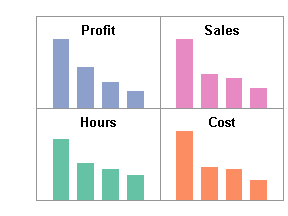

Use the Chart Labeler to add the labels in H19:H24 to the newly added Axis series, in the Left position.
Format the Axis series to hide the line, and to mimic axis ticks with cross markers that match the color of the plot area border.
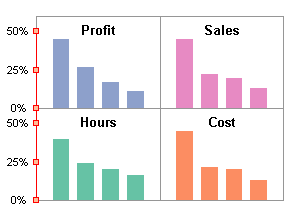

Finally, add the employee category labels to the bars. Use the chart labeler to apply the labels in C8:M8 to the Hours and Profit series, and the labels in C9:M9 to the Cost and Sales series. I used the Inside Base orientation.

You can download a zip file containing my worksheet with the 2-by-2 panel chart in this tutorial.



Chandoo says
Excellent tutorial Jon. I am sure there are situations where this would be very helpful. But a lazy bum like me would probably make 4 charts and align them in a matrix.
Jon Peltier says
Chandoo –
The advantage to having all of this information in a single Excel chart is that the “axes” will always be lined up. My Panel Charts with Different Scales tutorial illustrates this more clearly. You can spend half an hour aligning the Y axes of charts with different Y axis values, and then change the magnitude of values on one of these axes, and you need to spend time again to realign the axes. A panel chart, among other things, eliminates the tedium of repeating this task.
To help reduce the burden of creating a panel chart, I am in the initial design stages of a utility to generate panel charts. It will probably be ready before the next version of Office, but not by much.
Liu 's chart blog says
It is quite complex, if I need to make a “panel chart”,I would rather draw a chart , then duplicate it into four charts ,and put them together,it is more simple, wouldnt need too many time .
Jon Peltier says
Hi Liu –
Yes, it is complicated. But after going through the exercise a few times, it sorts itself out in your mind. As long as you remember your algebra from 8th grade, the formulas are not too complicated.
The benefit, as I explained to Chandoo, is that locking everything up into panels in a single chart is that alignment is made simple and robust. Changing a scale or adding other details will not force realignment of all of the constituent charts.
Could you imagine constructing either Panel Chart Example: Chart with Vertical Panels or Births by Day of the Year by lining up six or eight separate charts? The examples are easy, to teach the concepts. The student then applies these conceepts to specific complicated situations.
Chandoo says
@Jon: Agree that axis and plot area alignment is a pain. Just to test it I tried to make the same panel chart using 4 chart objects and alignment. here is the result: http://i287.photobucket.com/albums/ll133/pointy-haired-dilbert/panel-chart-using-4-charts.png
I have used axis scaling and set the right side chart’s axis labels to white color (and background to transparent ) and aligned them in a matrix. I guess this is an easier approach. The technique is to retain the axis and make the labels white color than altogether remove them.
Jon Peltier says
There are some panel charts which would not let you get away without showing lines between the panels. See for example the two I linked to in the comment above yours. As soon as alignment of line segments is crucial, separate charts does not cut it, unless you are willing to write VBA code to keep them aligned (I’ve done it, and it’s neither fun nor reliable).
odette says
I always visit your tutorials and have a great time trying the charts outs. I have a little question, when applying your chart to growth rate data and comparing quarters between two years, resulting in both negative and positive growth. The problem is I do not manage to calculate the “blanks” to get growth rates nicely aligned. Do you have any advice about what else to try? Thank you very much
Jon Peltier says
So 8 years of quarterly values provides only 7 growth calculations? You just need to provide for a blank to fill space in the chart.
(Or did I miss your meaning?)
Greeknl says
First of all thank you for the shared knowledge on this site. I would like to make a contribution. I used your tutorials to create my own graph and would like your comments.
The graph shows for five Companies (C_1) four Key Performance Indicators (KPI). Also the performance of the previous month and last year is shown for comparison on the services provided.
Martin Luxhøj says
Hi Jon,
I have a question regarding the tutorial Excel Panel Charts with Different Scales. Is it possible to aply this technique to different charttypes ie. other than a line chart. For excample 2 linecharts and a column?
Thank you for a very comprehensive homepage! It has been very helpfull for me many times.
Greetings from Denmark.
Martin
Jon Peltier says
Martin –
This can be applied to other chart types, such as area and column charts. You need to include hidden area or column series to make the area or column data float within the appropriate panel. This technique is shown in Stacked Charts With Vertical Separation.
Martin Luxhøj says
Jon –
Thank you very much. But I just can’t get it to work. My problem is how I have to handle the data for the hidden columns. Should these data be a part of the total share?
What I want to do is show a column chart which includes for example turnover, GM, GM% and maybe avg. sales price (x-axis). These are parameters with a large variance in scale so the panel chart with different scales would be perfect for this. Sadly I’m having problems implementing the data for the hidden columns.
Could you please give me a pointer as to how to handle the “hidden data”?
Thank you in advance.
Martin\
Jon Peltier says
Martin –
The visible and hidden columns are all stacked. The visible columns are based on scaled values, so for the scale, the calculated values range from 0 to 1. Since the columns are all less than 1 in height, the hidden columns have a calculated height that when added to the lower value produces a total of 1. The upper columns then stack on this value.
DaleW says
Very cool, Jon. Perhaps Office 2020 will support panel charts without Herculean efforts?
One tangential question: your impressive “templates” typically don’t make it drop-dead obvious which cells are user inputs and which cells are calculations and which cells are ad hoc workarounds, through color scheme or labels or segregation or arrows. Granted, it wasn’t too hard to figure out even for your involved example here, as the inputs logically were all at the top. For reusable workbooks like this which accomplish a task based on the inputs, do you think making the inputs really obvious by some color scheme (etc.) would be worthwhile and practical? Or are inputs best found by examining the F5 [Go To] Special Constants for likely candidates?
Jon Peltier says
Dale –
Good point about the formatting. When I make a template for a client, I apply some typical formatting to the worksheet. Any cells requiring input are generally colored light yellow or light green. These will be the only unlocked cells in the sheet, and the worksheet will be protected, usually without a password, so that these are the only cells the user can alter. The rest of the cells stay white background, with simple borders to help guide the user’s thought process. I try to put intermediate calculations off to the side, then I hide all rows and columns outside of the display area (including the calculations). I also lock any charts, but provide buttons that call code to export them to PowerPoint or Word.
In my tutorials, I shade cells to show the function of the data. In this post, for example, I have different colors for series names, category labels (X values), and Y values, etc.
Bobby Bluford says
I love this tutorial, Jon. I’m always looking for ways to quickly show my team- other executives and business thinkers- quick ways to look at their business. They don’t always have or want to spend the time to figure things out. Pictures and graphs are always better. In this case, the 2×2 allows you to present a lot of information in a small amount of space. I’ll definitely try it. If I’m able to work it out and learn it, I’ll share it (along with credit to you, of course) on my blog.
Marion says
Jon, I like the sleek look a lot but I am having one (very basic) problem. I can’t seem to get Excel 2010 to plot the XY graph with an X value axis. As a result, the labels are placed at Hours (1, 0.85) and (E1, 0.85); and Profit (E2, 1.85) and (M1, 1.85).
Everything goes as you outline until I plot the second set of data, the bars appear the same as your demonstration chart, but they are not outlined in red. On the next step I have a distorted “Z” pattern. Thanks for the tutorial.
Marion says
OK, nevermind, all is well. Thanks for the details in this piece, it’s a real skill builder